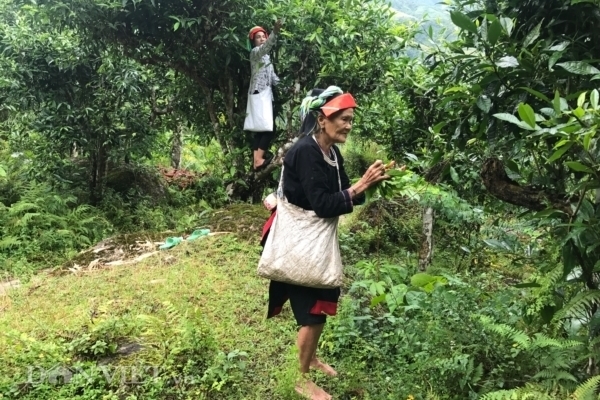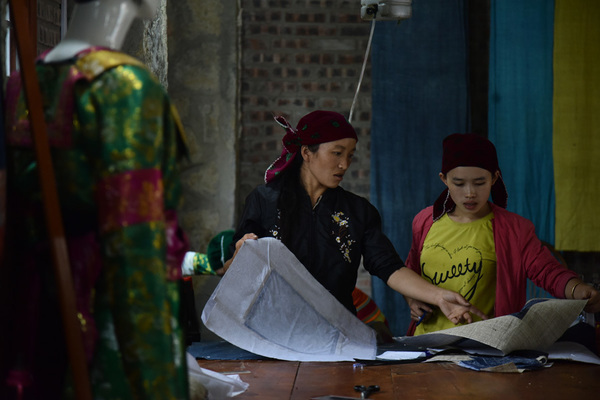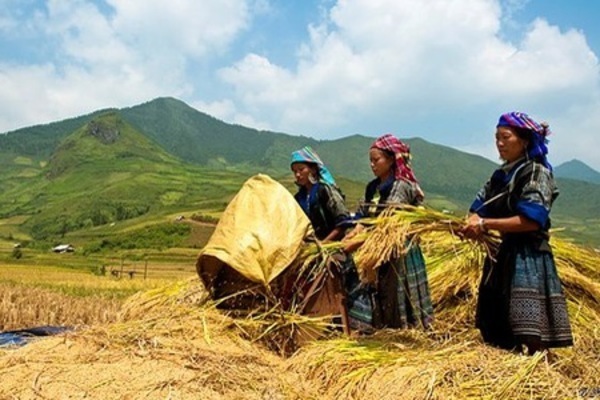 |
|
As of October 2019, almost 100% of the households in Cao Bo commune grow tea.
|
The Party and the Government of Vietnam have always determined that sustainable poverty reduction is the goal and mission of utmost importance to help ethnic minorities to have a better life, so that "no one will be left behind" and the mountainous areas can catch up with the plains.
Ha Giang is the home of 22 ethnic groups with many unique traditional cultural values. Due to the rugged terrain and harsh climate, local people were sometimes in hunger.
Joining the delegation of the Standing Office on Human Rights and the Ministry of Information and Communications, we crossed the narrow, bended mountain road and waded through fast-flowing streams to reach Cao Bo commune (Vi Xuyen district), which is dubbed the "kingdom" of tea as most of the tea trees here are about 300-500 years old.
“No one knows when these old tea trees appear but they are estimated at about 300-400 years, even 500 years old. Therefore, these old tea trees are called ‘the gift from the gods’ of the Dao people in this remote area," said Mr. Ly Quoc Hung, Chairman of the Cao Bo Commune People's Committee.
Previously, the people of Cao Bo did not take advantage of the nature's benefits so they only planted rice and vegetables all year round. Consequently, they were usually in hunger. Thanks to the assistance of the Party, State and the authorities at all levels, many families have changed their thinking and found out the key plants for cultivation. They are tea, cardamom and medicinal plants, but the most important plant is still the tea tree. Thanks to that "heaven-giving" tree, the life of the Dao Cao Bo people has improved in the past few years.
As of October 2019, almost 100% of the households in Cao Bo commune grow tea.
Cao Bo has two main types of tea trees, including: Upland tea with a higher percentage of sugar and lowland tea with more tannin, with a very specific acrid taste. Both types have huge consumption.
“In the second and the third lunar month, Cao Bo tea is sold at the price of VND60,000 per kilo ($2). The price doubled in 2019. In the first 6 months of 2019, the whole commune has harvested 200 tons of fresh bud tea with an estimated value of VND10 billion. On average, each household has an income of about VND42-43 million per year. Some households get rich thanks to the tea tree, with an annual income of several hundred million VND.
 |
|
"To have a more developed society, women must have jobs". Photo Dieu Thuy
|
Many families earn net profit worth hundreds of millions of dong. Thanks to the tea tree, local people have gradually escaped from poverty.
Sa Phin upland commune is located in the center of Dong Van district. Compared to Cao Bo, Sa Phin commune has more advantages in economic, cultural and social conditions when it owns many beautiful landscapes and tourist sites, particularly the vestige of the Vuong Family. However, Sa Phin is a hot spot in order and security, where human trafficking is a big problem.
Arid land, harsh climate makes the H’Mong people here unable to cultivate agriculture and raise cattle efficiently. Many H'Mong people from Sa Phin were forced to cross the border to China to work illegally to earn a living for themselves and their families. However, the income from these illegal jobs was usually not high. They also faced a full range of risks, such as: dangerous working environment, labor exploitation, fraud, etc.
Now these are memories. Thanks to the restoration of traditional professions, the H’Mong women have a more prosperous and happier life, thanks to stable income.
With the motto "to have a more developed society, women must have jobs," Dong Van district government has always tried to empower women.
Following this motto, the Lanh Trang Agricultural and Services Cooperative was established with the support and effort of the authorities of Dong Van district, Dong Van district women's union and some prominent individuals such as Ms. Sung Thi Si (currently the cooperative’s director, Ms. Sung Thi Ly, etc.
Since it was put into operation in 2017, the cooperative has created official jobs for 95 women in Dong Van District with a stable income of VND5-6 million and opened up extra job for hundreds of others in Ha Giang Province.
To fulfil “no one will be left behind” goal
For many years, the whole political system has made great efforts to implement the national target program on sustainable poverty reduction; Capital allocation program from the CPRP program and Program 135. Regarding these national action programs, the Party and the State always identify that for ethnic minority areas, sustainable poverty reduction is an extremely necessary and urgent goal and task to help the people to have a better life, so that "no one will be left behind", so that the mountains can keep up with the plains.
 |
|
The National Assembly passed a resolution on the approval of the Master Plan on socio-economic development in ethnic minority and mountainous areas in the period of 2021-2030.
|
Policies on socio-economic investment and development and poverty reduction have created a clear change in infrastructure, with about 25,000 infrastructure works built in communes, villages of particularly difficult conditions in the remote and mountainous areas.
Particularly, under Program 135, which is part of the National Target Program on Sustainable Poverty Reduction in the 2016-2020 period, since 2016 nearly VND20 trillion has been allocated, including over VND15.3 trillion from the central budget and nearly VND4.3 trillion from local budgets, to assist the development in the communes in extremely difficult conditions, communes in the border and mountainous areas. So far, 2,138 communes and 3,973 villages have benefited from this program.
Vietnam’s efforts in poverty reduction in general and poverty reduction in ethnic minority and mountainous areas in particular have gained many achievements, which have been highly appreciated by the international community. This is also the highlight in the system of social security policies, creating changes in the appearance of the ethnic minority and mountainous areas. Thanks to this, the life of the H’Mong people in Ha Giang in particular and the people in many other remote areas is experiencing positive changes.
On November 18, 2019, with 89.44% of the National Assembly deputies voting in favor, the National Assembly officially approved the Resolution approving the overall scheme on socio-economic development of ethnic minority and mountainous areas in the 2021-2030 period. Accordingly, by 2025, Vietnam targets to raise the average income of ethnic minorities twice compared to that of 2020 and by half the national average by 2030.
Hopefully, in the near future, there will be more good stories as we witnessed in Cao Bo and Sa Phin – the vivid examples of Vietnam's efforts to ensure human rights in remote and mountainous areas.
Minh Van